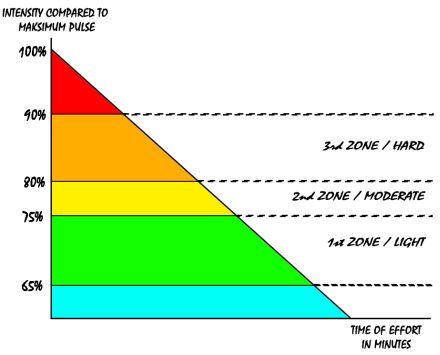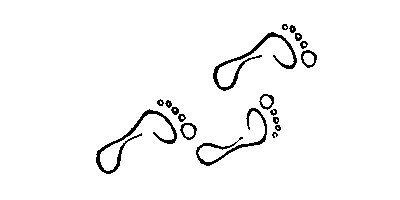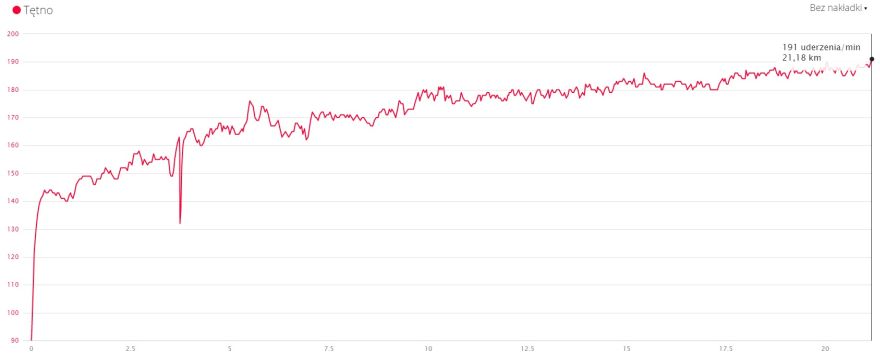It is commonly said that running is addictive. We begin running for a variety of reasons, but over time, we notice that we already can’t live without it. And then this morning or evening run itself is no longer enough – we want something more. In the TV we watch various running competitions and we begin to think about taking part in them ourselves, maybe even think about completing a marathon!
Our jogging turns into workouts – or so we call it. But how aware are we of what actually achieve with those running sessions? Do we know how to measure it?
If we want to improve in running, we must approach our training with awareness. Each workout affects us in some way, and we should be aware of this effect and even better if we could plan it ahead. There are various training methods that we can utilize. Some allow us to prepare for sprints, while others to a long lasting effort, like marathon, yet another to trail mountain races.
DEFINE YOUR HEART RATE TRAINING ZONES
You’d say: why do I need it at all? I just want to run, not sit with a calculator and put everything to pieces. No problem – not everyone needs to calculate their lactate threshold or maximum oxygen uptake. However, not everyone is able (especially novice runners) to listen to the body and determine the exercise intensity based on their feelings, and the line between a regeneration and endurance run can be very thin.
What is more, most of the runners who begin training, already possess heart rate monitor that will do all the work for them. You just need to know how to read these results. And if you don’t have a heart rate monitor, well, anyone can put a finger to the carotid artery and count, right?
Commonly three heart rate training zones are used. They can be determined using professional physiological tests on treadmills, but most of us do not have a lab at hand or just don’t feel the need to spend money on it. In such case, we need realy on heart rate readings, preferably from as many trainings as possible.

Maximum heart rate can be determined with appropriate formulas or using the direct method.
- There are a whole bunch of calculators available widely on the internet. They are based on the following formulas:
a / HRmax = 210 – 0,65 * age
b / Women: HRmax = 210 – 0,5 * age – 0,022 * weight
Men: HRmax = 210 – 0,5 * age – 0,022 * weight + 4 - The direct method is a test using a heart rate monitor. Perform 10-15 minute warm up (may be in the form of free jog), and a good stretch – the body must be ready for maximum effort.
Make sure the heart rate monitor strap clings well to your chest and won’t slide off.
Test:
Run with increasing speed for approx. 5 minutes. Control the pace so as not to reach the maximum speed too fast – it should be achieved in the last minute of the run. A good idea to perform this test is a short race (up to 5 km). During the event, there is an extra motivation in cempetition with other runners and it’s easier to overcome the discomfort accompanying such high intensity.
After the test cool down trotting for a few minutes and then read your maximum heart rate from the memory of the watch/heart rate monitor or upload the data to your computer. It is a better solution because the chart can show some unnatural heart rate jumps (errors), which should be rejected. Heart rate should increase linearly. Finally, you can compare the result with the calculation of the formula. If the discrepancy is large, retest – perhaps you didn’t reach your maximum.
TRAINING METHODS
Continuous trainings:
jogging (<65% HRmax) – the easiest form of running, very slow, not overloading the heart. During jogging you actively recover. The appropriate HR zone for warm-up or cool-down. For novice runners is the recommended form, through which the body adapts to the new form of activity. Professional runners use it for recovery after exceptionally heavy training.
1st HR zone run (65-75% of HRmax) / LIGHT – This type of training appears in almost every training plan and it is an essential means for improving aerobic endurance. It is a continuous effort, performed slightly faster than the warm-up – our heart rate should stay within the range of 65-75% of HRmax throughout the run.
2nd HR zone run (75-80% HRmax) / MODERATE / marathon pace – this is the most important training means for building long-ditance runners endurance. Speed during this type of trainings is very close to a race speed on long distances (hence the name of „marathon pace”. The appropriate distance for such a training ranges between 6 and 20 kilometers.
3rd HR zone run (80-90% HRmax) / HARD – very intensive form of training used in pre-race periods. It is an important element in preparing for shorter distances. Trainings in the 3rd HR zone require longer recovery, preferably with additional biological regeneration treatments (sauna, massage, saline baths).
Increasing speed run – The training means consisting of easy run (1st zone), continuous run (2nd zone) and intensive (3rd zone). Included into trainings after getting accustomed to continuous runs in each zone. The key is transgressing several speed thresholds with each segment (shorter every time) covered by approx. 5-10 sec/km faster. It is a very effective meas of training of both physical form and psyche.
Cross run – run in varied terrain (downhills and ascents). It is a means developing leg strength training, improving running technique and psyche (by pace changes, depending on the slope of the terrain). We distinguich passive cross runs, or run „to pass”, without the active involvement, and active cross run, where we consciously overcome intense ascents and downhills.
Long run – a run performed in the lower zones (jogging or 1st zone), but lasting longer than 70 minutes (even up to several hours). This training means builds endurance, teaches the use of other types of energy than easily accessible muscle glycogen and most intensively training long-distance runner’s psyche.
Intervals:
Intervals are short segments repeated several times, in sets„segment/rest”. They aim at diversifyin monotonous workouts. It is a training meas improving running technique, speed and dynamics. This type of training is very intense, fatigue afterwards is deep and requires longer (preferably also supported) recovery. Longer intervals are performed with lower intensity, often during the preparatory period, and shorter ones with higher intensity – these are put into practice during pre-start period.
With regard to interval intensity, we distinguish:
- Rhythms – short segments (100-500 meters) ran at an accelerated pace (80-85% of the capacity). When performing rhythms it is important to use a pace that will allow to maintain proper running technique throughout all repetitions.
- Sprints – a kind of training similar to rhythms, but much more intense. The aim of the sprints is to obtain the highest possible speed. In the end, they are performed even with the maximum achievable speed. Extremely important is a good warm-up before performing sprints. Work done by the muscles is intense and without proper warm-up one can easily strain a muscle. Another important thing is sufficient rest. Between sets we walk 2-4 minutes. The breaks can be lengthened, but categorically not reduced. For the next set one should approach in a state of relaxation and mental readiness.
With regard to type of interval:
- full rest intervals – in which the break between sets is long enough for the body to fully rest (eg. interval 500m/1000m rest)
- partial rest intervals – a lot more intense, where relaxation is equal to or shorter than the interval (eg. interval 100m/100m rest)
- time intervals – we define the duration of the interval and rest. Example: interval – 60 sec (pace 4:20 min/km); rest – 60 seconds (pace 5: 00min/km).
- distance intervals – we define the distance to be covered. Example: interval – 500m (2:05 min); rest – 1000m (5:00 min).
Strength training:
Strength training is an element shaping strength, endurance and technique of running . Often underestimated by runners, it is a very important stimulus for the whole organism. Strength training workouts should be included in our trainings 1-2 times a week (depending on our shape and stage of preparation). Strength training exercises include:
- skips– dynamically performed strength exercises. We distinguish well known to everyone from PT lessons: A-, B-, C-skips and multi-jumps. They are performed dynamically at straight sections of 100-200 m.
- ascent runs – used by more advanced runners, quick segments ran uphill. The slope and distance are adapted to our fitness level and preparation stage. Ascents are performed usually at 70-80% of our capacity.
- strength exercises– all kinds of other strength exercises, often more static. Thanks to them we maintain proper hygiene of the muscular system. It consists of various exercises for legs, but also other parts of the body and the deep muscles. Runners often forget in training of the upper body muscles, yet balance in the physique is very important – in fact our whole body works during running. Deep muscles, especially abs and back, help maintain correct posture and running economics – muscle sore in our arms and shoulders after the trail mountain race should teach us not forget about these exercises.
- Stretching exercises – apart from muscle strength, it is important to keep their flexibility. Runner’s muscles often work to a limited extent (especially in long-distance runs) and tend to shorten and contract. Therefore, after a workout, when the muscles are well warmed up, it is recommended to do a set of stretching exercises that will improve the scope of muscle work and relax them after training, speeding up recovery.
Regeneration:
Many runners approach their passion with full commitment, focusing on training and forgetting about the very thing, which is the basis of fitness improvement – regeneration. While the training itself is a stimulus for the body, it is the rest and recovery that is vital to even start talking about making any progress. During that time the body will recover after effort and adapt to new conditions. Without proper regeneration, training quickly leads to overtraining and injury.
Even if a runner is aware of the importance of proper rest and sleep to make the progress, this aspect is treated with a pinch of salt. Training alone is enough time-consuming, and therefore adequate rest and physical renewal are perceived as a luxury and unnecessary bonus. Of course there is a whole range of possibilities of regeneration – sauna, saline baths or relaxation massages, but these elements gain importance for the more experienced runners and professional athletes.
For amateur runners, the most effective methods of regeneration, on which you should focus are simple elements, such as a good hydration, proper diet and the right amount and quality of sleep. So keep those elements in mind and enjoy the benefits of recovery. Remember – sleep well while your shape improves :-)




